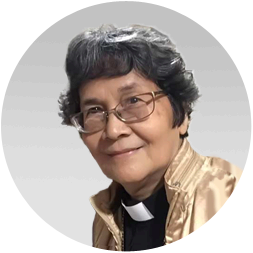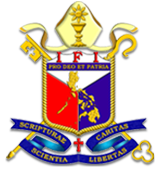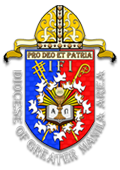CHRISTMAS SYMBOLS
(Reprinted with permission from “Celebration Guide for Advent and Christmas,” booklet published by the Iglesia Filipina Independiente and issued at the National Clergy Convocation, Davao City, November 19, 2018.)

By: The Rev. Victoria S. Esguerra
THE CELEBRATION OF CHRIST'S MASS, abbreviated as Christmas or Xmas (X = “chi” [“kai”] in Greek, meaning “Christ” or the “Anointed One,” or “Messiah” in Hebrew) is done by Christendom worldwide at this time of the year. The Philippines has the longest season of this celebration in the world - from the start of the “Ber” months (September, October, November) and finally to December and into Epiphany (The Magi), January 6. Even during the time of Advent, the Christmas songs (carols) and music are already in full blast over the air waves. The Christmas and Advent Seasons are fused into one; with all the signs and symbols displayed indicating the joyful expectation of the Season.
According to the strict Christian calendar, the two Seasons, Advent and Christmas, are two separate celebrations for the Church. Advent starts after Christ the King Sunday, last Sunday in the Season of Pentecost or Trinity. It consists of four Sundays of Advent (1st, 2nd, 3rd, and 4th) in December, and the nine (9) days/early morning Masses [Misa de Gallo], from December 16 to 24. Some churches celebrate the evening Masses [Simbang Gabi], from December 15 to 23, as the 24th is the eve of Christmas.
The Season of Christmas really starts on Christmas day, December 25th and lasts through the eve of Epiphany, January 5th, thus consisting of 12 days. Hence, we hear of the song, “12 Days of Christmas” sung in the western countries. In this Season, as the song goes, a person gives his/her loved one a gift for each day corresponding to the number of gifts per the number of day/s in Christmas - hence, one partridge on Day 1, two turtle doves on Day 2, three French hens on Day 3, etc.
During the early mornings of Misa de Gallo, the Filipinos attend the Holy Masses at 4:00 A.M.; then they buy and eat the “goodies” sold at the nearby food stalls: rice cakes (“puto bumbong,” “bibingka,” and other delicacies). Christmas eve is spent in family reunions, gathered at the sumptuous dinner table called “Noche Buena” [literally meaning “Good Evening”]. Subsequently, Christmas carols are sung, gifts are exchanged, followed by pleasantries and updates on life stories. On Christmas day, the children visit their “ninong/ninang” (Godparents) to receive their “Aguinaldo” (Christmas presents). The remaining days in the week are spent in holiday merry-making: carolings, carnivals, movie-watching, concerts, etc.
But before Christmas (even before Advent), as early as November right after “Undas” (All Saints' Day on November 1 and All Souls' Day on November 2), the Filipino homes and commercial establishments are already decorated with the signs of the spirit of the Christmas Season; these are all familiar to us. They consist of bright and colorful hues; of different sizes, shapes, and textures; of different tones and moods; etc. We may not be aware of the sources of these traditional decors, but most have religious meanings or significance.
ADVENT WREATH. Circular in shape (indicating no beginning or end), the Advent wreath holds four candles (3 purple ones and 1 pink) which are lighted, one at a time, on the four Sundays of Advent. Representing “hope,” “peace,” “joy,” and “love,” the candles also symbolize the dispelling of darkness and the eventual arrival of the Savior Jesus Christ. Each candle symbolizes 1,000 years; hence, the four candles symbolize the 4,000 years that humanity waited for the world's Savior - from Adam and Eve to Jesus as foretold in the Old Testament. Some Advent wreath includes a fifth candle, white for Christ's purity; this is lit on Christmas eve or Christmas day.
The purple candles represent the penitential character of Advent - spiritual preparation for the coming of the Christ (traced back to the early middle ages). But now, the purple candles symbolize our longing for the coming of our Savior Lord and our desire to be with our Heavenly Father. The rose (pink) candle on the third Sunday of Advent symbolizes the joyful expectation of this Coming.
CHRISTMAS TREE - first used by the Germans who brought it to the United States. The legend tells of the story of Winfred (8th century English missionary to Germany), also known as St. Boniface, who found a young prince in the woods who was supposed to be sacrificed alive, but Boniface cut down the “blood oak” (oak tree). A young fir tree miraculously appeared in its place. The Germans were the first to decorate the trees with stars and angels, candles in colored paper, and Christmas lights - attributed to Martin Luther, leader of the Reformation.
CHRISTMAS WREATH - originated from the wreaths or “coronas” (crown/circular shape) of the Roman headgear which they wore during festivals to honor the warriors upon returning from arduous battles. Only the royalty wore the golden “coronas” to commemorate the Roman gods. The meaning of the circular shape: for Christmas it meant the birthday of Jesus or Son of God; for Yule (pagan) it meant eternity or divinity for the Sun of God. Made of evergreen branches (“never truly dies”), the wreath is also used to decorate homes and buildings during the winter season.
POINSETTIA - also called the “Star Flower” because of the star-shaped leaves (actually the red petals are leaves without chlorophyl; the real flowers consist of the yellow petals at the center); also known as the “Flowers of the Holy Night” (“Flores de Noche Buena”). Native to Mexico and Central America, this plant is named after Joel Roberts Poinsett (1799-1851), physician, botanist, and politician (first U.S. Ambassador to Mexico), who discovered the plant therein in 1828. The Mexicans started using it as a Christmas flower in 1830-40. Poinsett introduced it to the U.S. in South Carolina.
MANGER - referred to the feed trough of animals (made of stone, not wood) which was the cradle of the Baby Jesus in the cave (stable) where He was born. The “Lamb of God” was warmed by the straw strewn on the manger and He was clothed with strips of cloth. He was surrounded by animals and the lowly shepherds were His first visitors. The Wise Men did not come to the manger; Jesus and His parents were already in their home when the sages arrived.
ANGELS - the word “angel” literally means “messenger” and the role of the angel is more pronounced in the Christmas story - the Annunciation of the Blessed Virgin Mary; the Good News of Jesus' birth to the shepherds out in the fields; the good news to Zechariah in the Temple about the birth of John the Baptist (forerunner of Jesus Christ); and the news to Joseph of Mary's faithfulness. Angels are spiritual beings and do not have physical bodies; sometimes they assume material forms when communicating with humans.
There are nine (9) orders of angels in the ascending hierarchy in heaven: Angels, Archangels, Thrones, Dominions, Principalities, Virtues, Powers, Cherubim, and Seraphim. Their roles or functions, with their leaders, are as follows:
- Angels - led by Gabriel - messengers of God.
- Archangels - (7 in all) led by Michael - provider of protection against the Devil.
- Thrones - led by Zaphkiel - teacher of the glory of the holy judgment.
- Dominions - led by Zadikiel - guide of the angels in doing their work.
- Principalities - led by Haniel - leader of the people in all corners of the earth.
- Virtues - led by Raphael - provider of the miraculous healing.
- Powers - led by Camael -- protector/guard against the evil spirits.
- Cherubim - led by Ophaniel - leader in wisdom and provider of light of knowledge.
- Seraphim - led by Merattron - leader in the holy love of God and uplifter of people to
experience the great love of God. (Only the Seraphim and the Cherubim are known to have wings.) As a Christmas décor, the Germans were the first to put angels on their Christmas tree.
STAR OF BETHLEHEM - the five-pointed Star visible in the sky during the birth of Jesus in 4 B.C. in Bethlehem south of Jerusalem. It illumined the sky and guided the caravans of the Three Magi (Wise Men) from the East to the home of Jesus. The Star of Bethlehem was also an instrument of God to light the darkened world. Some 2,000 years later (July 1996), the same Star was sighted again in the heavens this time by two American amateur astronomers somewhere in the desert in the State of Arizona (United States). Thomas Bopp and Alan Halle, separately, watched through their home telescopes this shining apparition. Scientific literature had earlier reported the appearance of the same Star (huge comet) which appeared in 4 B.C. The two astronomers saw the Dirty Snowball of frozen ice, gases, and dust. It had a coma, nucleus in the center, a two-mile length tail, and it received its light from the sun's reflection. According to astronomers, this particular Comet appears every 2,000 years, hence authenticating the birth of Jesus to be that on 4 B.C. The five-pointed Star of Bethlehem, now called the Halle-Bopp Comet, was the Symbolic Light of Unity for the world to gather in worship the Light of Truth and the Lord of Wisdom. The “Parol” is designed after the Christmas Star (Star of Bethlehem) which represents the beauty of the newly-born Baby Jesus; originally shown as a lantern by the Mexicans to decorate their homes. The star is also put as decoration on the pointed top (apex) of the Christmas tree (usually made of an evergreen tree).
THE MAGI (THREE KINGS) - Only the Gospel of Matthew mentions the Magi; but did not mention their number, their names, or what countries they were originally from. Mistakenly called “The Three Kings,” their number was inferred from the three gifts delivered - gold, frankincense, and myrrh. After converging at some point on the desert, they travelled together in caravans, so people assumed they were wealthy kings. The Western tradition indicated that they were the Three Wise Men because of the gifts; however, the Eastern legend said that they were twelve, not three. Legends from the West had given the Wise Men their names: Melchoir, Gaspar (Kaspar), and Balthasar. Biblical writers believe that the Wise Men did not arrive on the night Jesus was born in Bethlehem, but rather a year or more later (as King Herod ordered all the Jewish male children under two to be killed.)
SANTA CLAUS - named after Saint Nicholas, Archbishop of Myra (Greece), who died a martyr (December 6, 342 A.D.) under the Diocletian persecution. His name was synonymously used with Saint Nick and Father Christmas (English name). He was born to wealthy Christian parents in Patara in Lycia, Asia Minor (Turkey). An orphan at a young age because his parents died from a plague which struck the city, his loss drew him even much closer to God. He was chosen archbishop of Myra when he was in his early 20's. His life was secretly devoted to the needy (putting food/clothing under the doors of poor families). He was regarded as the patron of children; with the tales of works of charity extending to Russia, Germany, Italy, Greece, England, Switzerland, Belgium, and Holland. Emperor Justinian built a church in his honor at Constantinople in the suburb of Blacharnae about the year 340 A.D. After his death, a tradition of gift-giving was begun in his honor.
CHRISTMAS BALLS - symbolic of the church bells pealing (1350-1400) to announce the Christ's Mass. Also, Christmas balls “represent apples hanging on the branches of sacred trees which were used to make the spirits of nature and the fertility of the earth return.”
CHRISTMAS LIGHTS - symbol of the Light of Christ or the Way of Christ; a light which dwells in darkness - hope and good in the world. Some think that the lights represent the Star of Bethlehem which illumined the sky for the Magi to follow to Jesus' birthplace to Bethlehem.
CHRISTMAS CAROLS - songs of joy, praise, or devotion to Christmas or Easter (from the song of the angels at the announcement of Jesus' birth). The first Christmas carol was the “Silent Night” (1873) by F. Grueber (German composer in 1818), in the album of an American farmer; later sung by both Catholics and Protestants in the United States.
CHRISTMAS CARDS -- originated in England (UK) by Sir Henry Cole who inaugurated London's Victoria and Albert Museums. Designed by John Horsley, Cole's friend, the first 1,000 copies were sold in a London art shop. As printing methods improved and costs cheaper, Christmas cards became even more popular as postage dropped to half a penny. In the United States, the first cards were offered in 1875 in Roxbury, Massachusetts by Louis Bran (German immigrant). Hallmark cards became the leading printer/producer of Christmas cards (and other occasion cards) in the U.S.; later started exporting their cards. In the Philippines, the first Christmas cards were “born” in 1955, due to import-ban of U.S.-made Christmas cards; thus leading to a rise of artists and illustrators here. [During this digital age, the Christmas cards lost their popularity due to the quick messaging provided by the social media.]
(Note: Sourced from personal notes collected over time from various forms of literatures -books, pamphlets, news clippings, and bits-and-pieces of information from social media.)


